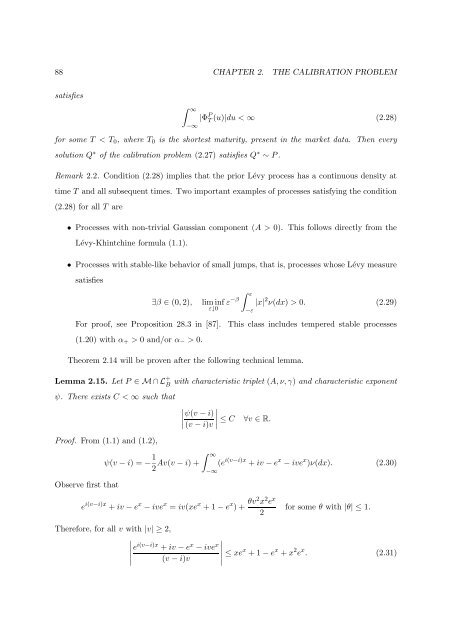Processus de Lévy en Finance - Laboratoire de Probabilités et ...
Processus de Lévy en Finance - Laboratoire de Probabilités et ...
Processus de Lévy en Finance - Laboratoire de Probabilités et ...
You also want an ePaper? Increase the reach of your titles
YUMPU automatically turns print PDFs into web optimized ePapers that Google loves.
88 CHAPTER 2. THE CALIBRATION PROBLEM<br />
satisfies<br />
∫ ∞<br />
−∞<br />
|Φ P T (u)|du < ∞ (2.28)<br />
for some T < T 0 , where T 0 is the shortest maturity, pres<strong>en</strong>t in the mark<strong>et</strong> data. Th<strong>en</strong> every<br />
solution Q ∗ of the calibration problem (2.27) satisfies Q ∗ ∼ P .<br />
Remark 2.2. Condition (2.28) implies that the prior Lévy process has a continuous <strong>de</strong>nsity at<br />
time T and all subsequ<strong>en</strong>t times. Two important examples of processes satisfying the condition<br />
(2.28) for all T are<br />
• Processes with non-trivial Gaussian compon<strong>en</strong>t (A > 0). This follows directly from the<br />
Lévy-Khintchine formula (1.1).<br />
• Processes with stable-like behavior of small jumps, that is, processes whose Lévy measure<br />
satisfies<br />
∃β ∈ (0, 2),<br />
lim inf<br />
ε↓0<br />
For proof, see Proposition 28.3 in [87].<br />
(1.20) with α + > 0 and/or α − > 0.<br />
Theorem 2.14 will be prov<strong>en</strong> after the following technical lemma.<br />
∫ ε<br />
ε −β |x| 2 ν(dx) > 0. (2.29)<br />
−ε<br />
This class inclu<strong>de</strong>s tempered stable processes<br />
Lemma 2.15. L<strong>et</strong> P ∈ M ∩ L + B<br />
with characteristic tripl<strong>et</strong> (A, ν, γ) and characteristic expon<strong>en</strong>t<br />
ψ. There exists C < ∞ such that<br />
Proof. From (1.1) and (1.2),<br />
Observe first that<br />
ψ(v − i)<br />
∣ (v − i)v ∣ ≤ C ∀v ∈ R.<br />
ψ(v − i) = − 1 ∫ ∞<br />
2 Av(v − i) + (e i(v−i)x + iv − e x − ive x )ν(dx). (2.30)<br />
−∞<br />
e i(v−i)x + iv − e x − ive x = iv(xe x + 1 − e x ) + θv2 x 2 e x<br />
2<br />
for some θ with |θ| ≤ 1.<br />
Therefore, for all v with |v| ≥ 2,<br />
e i(v−i)x + iv − e x − ive x<br />
∣ (v − i)v ∣ ≤ xex + 1 − e x + x 2 e x . (2.31)
















